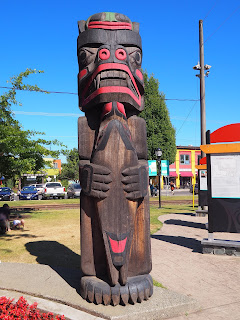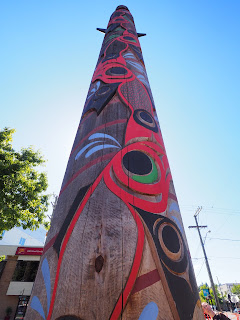 |
| Duncan |
With an area
of less than the old City of London, and a population of under 5,000, Duncan is
the smallest city in BC, but it does service the much larger (around 80,000)
outlying population. Like much of BC the city has roots in the lumber industry,
but it also sits in the fertile Cowichan Valley, so there is an abundance of
farming and nowadays, wineries too.
Of course,
with our diets seemingly in freefall, and being already full of Nanaimo bars,
we had to resist the temptation to check out all of the local wines.
Duncan is a
pleasant place. The original settlement here was called Alderlea, and was just farmland,
owned by William Chalmers Duncan. In 1887, he donated a section of the land for
the town to be created, and that was the beginning of Duncan.
The city has
a number of ‘heritage buildings’, that are probably quite interesting for
visiting Canadians or others from newer countries, but which we find difficult to
get excited about when they are only a hundred or so years old. That isn’t
meaning to be dismissive, but just a reflection of a difference in perspective.
As someone said to us recently Canadians are impressed by things that have even
a relatively moderate age, that feel new and inconsequential to Europeans, but
Europeans are put off by distances that Canadians wouldn’t give a second
thought to.
What we did
notice here, is that there was a better quality in the First Nations style
souvenirs available than we have seen generally. And that brings me nicely to
the reason that most tourists come to Duncan – the totem poles and Quw’utson Cultural
Centre.
 |
| World's largest hockey stick, Duncan |
Unfortunately,
the cultural centre was closed on the day we visited, but we did get to see the
largest hockey stick in the world. It was made for the 1986 Vancouver Expo, as
part of a collection of large items celebrating aspects of the Canadian
lifestyle, and bought by the city afterwards. Later in our trip, we would pass
through Houston on the train, which is home to another of these items, the
world’s largest fly fishing rod.
But enough
of inexplicably large paraphanalia, and back to what the city is really known
for - the totem poles. The City of Totems Project was begun by the then Mayor,
Douglas Barker in 1985, as a way to attract new visitors. They commissioned
numerous poles from recognised First Nations artists, and raised them around
the main streets. This is now the world’s largest collection of publicly
displayed totem poles, and in 2012, as part of their celebrations of the centenary
of becoming a city, they created a trail that you can follow to see them.
I have
chosen a number of the poles that we found more interesting for the photos, and
whilst I won’t tell you any of the stories that go with them – you can read
about those yourself if you visit one day – I have included details of what
they depict, so you can make them out more easily.
Wind Spirit, carved by Doug LaFortune in 1986, and the first one that he made for the collection. It shows a Thunderbird, a Wind Spirit, a bear and a halibut.
Three
poles, left to right are: The Feast, carved by Doug
LaFortune in 1987, showing
a bald eagle, a killer whale and Spirit Helpers; Raven’s Gift, carved by
Doug LaFortune in 1989, showing a raven, a totem pole, a man and a beaver; and
Pole of Wealth, carved by Hwunu’metse’(Simon Charlie) in 1988, showing a
Thunderbird, a Spirit, a killer whale, a black bear and a copper.
Transformation, carved by Laverne Roy ‘Corky’ Baines in 1987, showing a bald
eagle, a killer whale a man and a wolf.
Transformation in Life, carved by Chief Swaletthul’t’hw and Nelson Canute in
1987, showing an Eagle Guardian, a young person, a bald eagle and a man.
Two
poles, left to right are: The Friendship Pole, carved by Cicero August in 1987,
showing a bald eagle, a bear and a salmon; and Owl Pole, carved
by Khut-Whee-Mul-Uhk in 1987, showing an owl, a bear and a human.
Kwagu’l
Bear Holding a Seal, carved by Gwe-la-y-gwe-la-gya-les in 1987, showing a frog,
a bear and a seal.
Centennial Pole, carved by Kwagu’t Chief Tlasutiwalis in 2012, showing a bald
eagle, William Chalmers Duncan, a Thunderbird, a killer whale, a Chief Maker
(which honours women of the city) and a frog. It also has salmon on the rear of
the post.
the right hand pole is Thunderbird with Dzunuk’wa, carved by Moopin’kim in
1990, showing a Thunderbird and a Dzunuk’wa, or a wild woman.
Owl Spirit,
carved by Ketwtel (Tom LaFortune) in 1986, showing an owl, a Human Spirit and a
Chief.
Abolishment Pole, carved by Si-yaaxultun in 1990, showing a frog, a bear,
another frog and a youth. I have to wonder whether this one is intended as a
warning to any local tearaways, as the story is of a boy who kept terrorising
his tribe, so eventually was cast out, left to wander aimlessly and then die,
ending up covered in frogs.
Sea and
Sky, carved by Harold Alfred in 1990, showing a Thunderbird and a killer whale.
Peaceful
Boundaries, carved by Norman John in 1988, showing a raven, a Maquinna Sun
Mask, and a double headed serpent.
Cedar
Man Walking Out of The Log, carved by Gwe-la-y-gwe-la-gya-les in 1988, showing
a man holding a walking stick that itself is carved with a copper and family
crests of a baby Thunderbird, a killer whale and a man. This is the world’s
widest totem pole with a diameter of 1.8 metres. The cedar tree that it is
carved from is over 750 years old and has marks in the back where you can see
that planks were once taken out to make First Nations homes.
Three
poles, left to right are: The Guardians, carved by Khut-Whee-Mul-Uhk in 1986,
showing Watchmen and a bald eagle; Dzunuk’wa, carved by Hokwawadi in 1989,
showing a wild woman and a copper; and Chief’s Pole, carved by
Khut-Whee-Mul-Uhk in 1986, showing a human child, a killer whale, a Chief and a
copper.















No comments:
Post a Comment
We like to hear from you too, so please leave us a message here. We are also happy to answer any questions if we can help. Comments are moderated so will not appear straight away and there could be some delay in replying if we are travelling.